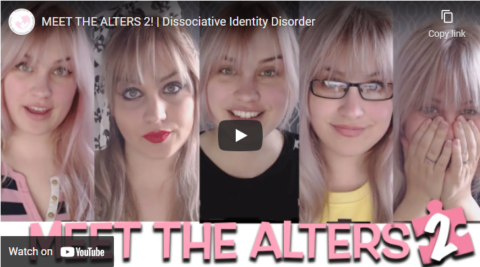Freddie deBoer has become convinced that there’s no such thing as “Multiple Personality Disorder”, despite the vastly increased numbers of young people with social media accounts who have built their online personas around their MPD or dissociative identity disorder (DID) issues:
The technical name is dissociative identity disorder, but it’s more commonly referred to as multiple personality disorder. It’s been in a thousand cheesy cop shows and legal dramas, too many novels written in MFA programs, and untold freshman Into to Psychology textbooks. M. Night Shyamalan’s films Split and Glass are typical of pop culture portrayals of the disorder as a lurid and impossibly dramatic disorder, with clear and distinct switches between entirely separate personalities that occur at the most narratively convenient times. And in recent years there’s been an explosion of interest and claims of diagnosis of the disorder, coincident with the rise of Tumblr and TikTok, where there are thriving communities of adolescents who claim to have dozens of “alters” and who refer to themselves as “systems”, along with a whole boutique identity vocabulary that they’ve developed. The number of views of videos tagged with #DID on TikTok is in the billions.
And yet.
And yet dissociative identity disorder is probably not even real. Its presence in the DSM has proven to be persistently and deeply controversial. Diagnostic criteria and standards are perceived by many to be highly impressionistic and unacceptably subject to the biases of the evaluator. The disorder reflects a cinematic and exaggerated vision of what mental illness looks like, which may make it more attractive to people looking for a diagnosis. DID is often presented as a kind of get-of-accountability-free card, as someone who claims to have it can always say that past bad behavior was caused by another personality and is thus not their responsibility. Many high-profile cases have been revealed to be frauds or, at least, the product of a therapist or doctor forcing patients to think they have it. The most famous DID patient, Chris Costner Sizemore of The Three Faces of Eve, claimed that her alters were not the product of childhood trauma but that she was born with multiple selves with fully-formed personalities, which completely contradicts the established etiology for the disorder.
Some who have claimed to have it have done so only after being accused of a crime. (An embezzler’s sole defense in a trial in the early 1980s was that an alter stole the money.) Diagnosis often involves the use of “recovered memories” and hypnosis, both of which are controversial if not outright discredited. And claiming to have it does not even require conscious dishonesty, just an active imagination and too much awareness of DID’s presence in culture. Regardless, the mere existence of the disorder provokes angry disagreement in a way that simply does not exist for other major psychiatric conditions like schizophrenia or bipolar disorder. Even proponents of the prevalence of DID acknowledge major overlapping symptoms with schizophrenia and major difficulties in diagnosis.
[…]
Even if we accept the disorder and are particularly generous in our criteria, the number of genuine cases from the past one hundred years is probably somewhere in the three digits. It’s that rare, if real. And its newfound prevalence among adolescents is particularly hard to understand, given that the condition has generally been identified among those in their 30s and 40s and is even rarer among the young. As stated in a 2011 lit review, “Despite continuing research on the related concepts of trauma and dissociation, childhood DID itself appears to be an extremely rare phenomenon that few researchers have studied in depth.”
The people who have traditionally been treated for DID have suffered, greatly, and not in the cool arty time-to-dye-my-hair-again type of suffering common to social media performance, but actual, painful, pitiable suffering. Those patients who have been diagnosed in the past with the disorder, by doctors, and who have spent years and years dealing with the consequences, are often truly debilitated people, whether the disorder itself is real or not. They require intense therapy, are often medicated with powerful drugs, and are frequently subject to long-term hospitalization. They tend to live broken and pain-filled lives, like most people with serious mental illness.
Of the dozens of high-follower DID accounts that I’ve seen, almost none are experiencing any of that. Plenty of them are in therapy, but judging from how they talk about it, it all seems to be of the customer service variety of therapy. Hardly any of them say they’re medicated, which I guess makes sense — every last one I’ve seen comes from the school that sees mental illness as some adorable personality quirk that makes them unique and high status, rather than as a source of great pain and personal destruction. They don’t take meds because they don’t think there’s anything to treat. And, indeed, they aren’t living debilitated lives. On the contrary, they’re flourishing, going about self-actualized and successful lives, getting into Ivy League schools, bragging about their social media clout, being girlbosses. This is the status of mental illness in youth culture today, where we are expected to extend every accommodation to those who say they have mental illness even as they would seem to require no accommodation at all; they would like the laurel of victimhood without the actuality of being victimized.
þ to Colby Cosh for the link.




